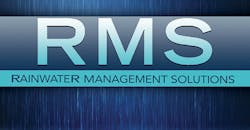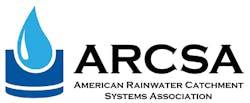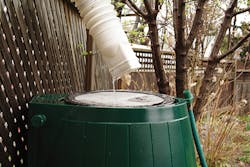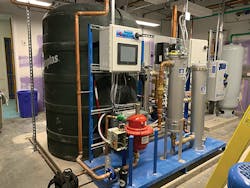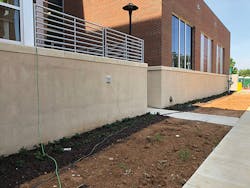Rainwater Harvesting Education Gaining Momentum Through Steadfast Leadership
ROANOKE, VA—For David Crawford, president, Rainwater Management Solutions, his dedication to rainwater management and conservation is admirable. The mission of the company is to educate and provide a common sense approach and affordable rainwater harvesting systems for both commercial and residential systems. “The end goal for our company is saving our precious water resources,” says Crawford.
Impressively, the company has a combined 80 years of experience, has been in operation for 20 years, and is considered one of the leaders in the industry. The company has supported American Rainwater Catchment System Association (ARCSA) for the last 16 years, as well as many other organizations that promote water conservation through rainwater harvesting, and provides design and sales of gray water systems throughout North America for commercial applications.
Nonetheless, having served in many capacities as a volunteer with ARCSA, Crawford, who also served as president of the organization for five years—and currently serves on the board of the ARCSA C3 and many other committees promoting Rainwater Harvesting and Water conservation—believes education has been the most demanding aspect in terms of promoting the industry. “Through ARCSA, I have served on many code committees and standard committees throughout the U.S. As a member and president of ARCSA, our company has worked on international projects in Haiti in other areas and water deprived countries,” says Crawford.
In fact, Rainwater Management Solutions, Inc. was selected by the U.S. Green building Council to provide a water quality harvesting and treatment system for a new orphanage in Haiti, and had also worked with ARCSA on developing and supplying systems to other orphanages in Haiti. ARCSA and its members also work with other organizations for areas such as Mexico, Peru, and many other countries. In the U.S., ARCSA has members involved with systems at the Navajo Indian Nations reservations.
In addition, ARCSA works with, and is supported by, the International Plumber’s Union and the International Laborers Union, and has many of their members involved in projects, training and certification. “Through the support of these two organizations we have been able to expand our reach and our educational program, as well as develop a third-party certification and online training certification for designers and installers,” says Crawford.
Yet, due to the pandemic, this year has been extremely challenging for everyone, and the rainwater catchment industry is no exception. For instance, ARCSA had to convert to an online conference and has a committee that is working toward what will be a good opportunity for the organization coming up the first week of December. “We will certainly miss the handshakes and hugs of our organizational members, but feel we are offering a very good professional educational experience at a lower price. The end goal, and the most important one, is keeping everyone safe until our society can get a handle on the pandemic,” says Crawford.
Codes & Compliance
ARCSA constantly works on improving and educating communities across the Unites States about rainwater harvesting guidelines. “To that point we have published, along with the American Society of Plumbing Engineers (ASPE), the ASPE/ARCSA standard 63 for rooftop rainwater collection,” says Crawford.
The organization has also published standard 78, which is directed at collection of stormwater or surface water collection and reuse. “In doing so, we have worked with many organizations as the International Code Council (ICC) and the International Association of Plumbing and Mechanical Officials (IAPMO) group, which are the two major code bodies in the U.S.,” says Crawford.
However, there are more than 40,000 jurisdictions for local officials that deal with codes and approval processes for construction. Currently, many states and local authorities have come up with what they believe are their own guidelines for rainwater harvesting, some good some not so good, says Crawford. “We are working with many states right now and we can only hope that rainwater harvesting continues to gain momentum; this will force state and local officials to improve on the codes for rainwater harvesting to move this industry forward. Currently we are at the hands of the local officials and states with guidelines, however misguided some might be for approvals,” says Crawford.
Rainwater Basics
To reiterate, education is a key component to rainwater success. “After 20 years of being in the rainwater harvesting business, we have learned there is a fundamental five-step process each rainwater collection and reuse system needs to follow,” says Crawford. They are:
1. Pre-filtration. Pre-filtering rainwater prior to entering the storage tank eliminates large debris and the result of this increases the water quality, lowers the amount of tank and downstream maintenance.
2. Calming inlet. This allows the new water to smoothly enter the tank without disturbance.
3. Floating intake. This is a device that floats in the tank so the best water available is drawn by the pump and is below the surface and above the bottom of the tank.
4. Overflow device. This device helps to skim pollen or other small particles that may float in the tank, as well as creates an overflow with a trap that prohibits creatures from entering the rainwater collection system.
5. Point source of treatment. Based on the use of water collected, whether it be for toilet flushing, car washing, laundry or potable water, a system should be designed to meet the end use water quality requirements. The requirements vary and there is an array of filtration equipment to choose from depending upon the end use. Using the first four steps, a high water quality can be achieved and can reduce the risk for contamination. For potable water, additional considerations must be kept in mind—from beginning to end. For example, a carbon filter and a UV light can produce high-quality water that is bacteria-free
The steps are outlined on the Rainwater Management Solutions website for further explanation. (For diagrams and further resources on the first four steps, visit https://rainwatermanagement.com/pages/wisy-4-step-process.)
“We do see new inventions and products that increase water quality, such as our new in-line pre-filtration unit for large commercial facilities, as well as our modernized controls system for monitoring and maintaining small to large commercial systems. These controls can interact with building maintenance systems to help their owners maintain a healthy and low maintenance cost system as well as monitor water usage,” says Crawford.
The huge challenge moving forward is seeing a national code come to fruition. Presently, there is a national standard that has been vetted and approved—ASPE/ARCSA standard 63 and standard 78. This will serve at the present as a guideline for municipalities and others to use in determining the proper process for rainwater harvesting, says Crawford, which will promote healthy systems with low maintenance and a high quality of water.
[sidebar]
Rainwater Harvesting in Action: The Fralin Biomedical Research Institute at Va. Tech Carillion
Owners at the Fralin Biomedical Research Institute at Virginia Tech Carillion, located near downtown Roanoke, Va., wanted to reduce their over water consumption impact at the site and attain LEED points for their building. Rainwater Management Solutions was contacted by the engineering team for the project, to assist with design layout, equipment procurement, and manufacturing of a package system for their rainwater harvesting needs.
Mechanical equipment is used to filter, disinfect and distribute the harvested rainwater. The water is filtered down to 5 microns and disinfected with ultraviolet disinfection to eliminate bacterial and viral growth. The clean water is stored temporarily in a 1,000-gallon water storage tank where it will be redistributed to water closets and irrigation system. A flow meter tracks total rainwater used for the building to date.
The water is being directed back into the building for toilet flushing, as well as being used for outdoor irrigation. This was the first commercial rainwater harvesting system of its kind for the university and has sparked further implementation of rainwater harvesting systems on future buildings for Virginia Tech.
On high demand days, the building is consuming roughly 3,000 gallons of rainwater. On low demand days, the building is consuming 1,000 gallons of rainwater. The building will reduce annual water consumption by roughly 750,000 gallons per year.
